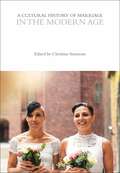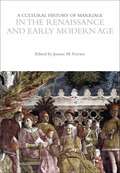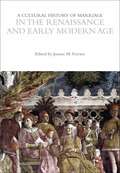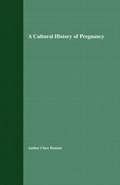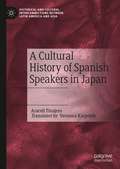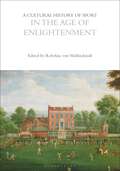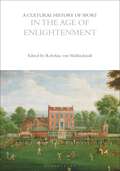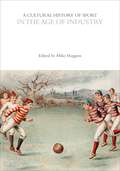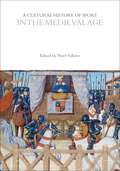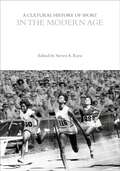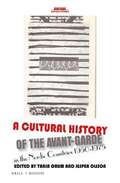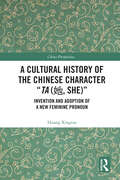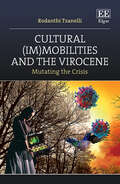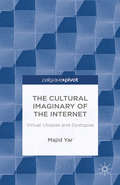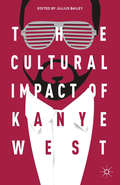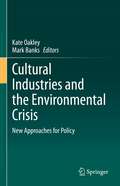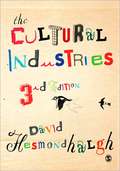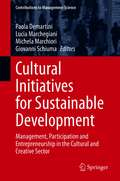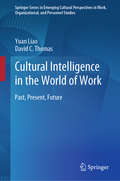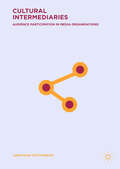- Table View
- List View
A Cultural History of Marriage in the Modern Age (The Cultural Histories Series)
by Christina SimmonsSpanning cultures across the 20th century, this volume explores how marriage, especially in the West, was disestablished as the primary institution organizing social life. In the developing world, the economic, social, and legal foundations of traditional marriage are stronger but also weakening. Marriage changed because an industrial wage economy reduced familial patriarchal control of youth and women and spurred demands and possibilities for greater autonomy and choice in love. After the Second World War, when more married women pursued education and employment, and gays and lesbians gained visibility, feminism and gay liberation also challenged patriarchal and restrictive gender roles and helped to reshape marriage. In 1920 most people married for life; in the twenty-first century fewer marry, and serial monogamy prevails. Marriage is more diverse and flexible in form but also more fragile and optional than it once was.Over the century control of courtship shifted from parents to youth, and friends, as opposed to kin, became more important in sustaining marriages. Dual-wage-earner families replaced the male breadwinner. Social and political liberalism assailed conservative laws and religious regimes, expanding access to divorce and birth control. Although norms of masculinity and femininity retain huge power in most cultures, visions of more egalitarian and romantic love as the basis of marriage have gained traction-made appealing by the global spread of capitalist social relations and also broadcast by culture industries in the developed world. The legalization of same-sex marriage-in over twenty-five nations by 2020-epitomizes a century of change toward a less gender-defined ideal that includes a continued desire for social recognition and permanence.A Cultural History of Marriage in the Modern Age presents an overview of the period with essays on Courtship and Ritual; Religion, State and Law; Kinship and Social Networks; the Family Economy; Love and Sex; the Breaking of Vows; and Representations of Marriage.
A Cultural History of Marriage in the Modern Age (The Cultural Histories Series)
Spanning cultures across the 20th century, this volume explores how marriage, especially in the West, was disestablished as the primary institution organizing social life. In the developing world, the economic, social, and legal foundations of traditional marriage are stronger but also weakening. Marriage changed because an industrial wage economy reduced familial patriarchal control of youth and women and spurred demands and possibilities for greater autonomy and choice in love. After the Second World War, when more married women pursued education and employment, and gays and lesbians gained visibility, feminism and gay liberation also challenged patriarchal and restrictive gender roles and helped to reshape marriage. In 1920 most people married for life; in the twenty-first century fewer marry, and serial monogamy prevails. Marriage is more diverse and flexible in form but also more fragile and optional than it once was.Over the century control of courtship shifted from parents to youth, and friends, as opposed to kin, became more important in sustaining marriages. Dual-wage-earner families replaced the male breadwinner. Social and political liberalism assailed conservative laws and religious regimes, expanding access to divorce and birth control. Although norms of masculinity and femininity retain huge power in most cultures, visions of more egalitarian and romantic love as the basis of marriage have gained traction-made appealing by the global spread of capitalist social relations and also broadcast by culture industries in the developed world. The legalization of same-sex marriage-in over twenty-five nations by 2020-epitomizes a century of change toward a less gender-defined ideal that includes a continued desire for social recognition and permanence.A Cultural History of Marriage in the Modern Age presents an overview of the period with essays on Courtship and Ritual; Religion, State and Law; Kinship and Social Networks; the Family Economy; Love and Sex; the Breaking of Vows; and Representations of Marriage.
A Cultural History of Marriage in the Renaissance and Early Modern Age (The Cultural Histories Series)
by Joanne M. FerraroWhy marry? The personal question is timeless. Yet the highly emotional desires of men and women during the period between 1450 and 1650 were also circumscribed by external forces that operated within a complex arena of sweeping economic, demographic, political, and religious changes. The period witnessed dramatic religious reforms in the Catholic confession and the introduction of multiple Protestant denominations; the advent of the printing press; European encounters and exchange with the Americas, North Africa, and southwestern and eastern Asia; the growth of state bureaucracies; and a resurgence of ecclesiastical authority in private life. These developments, together with social, religious, and cultural attitudes, including the constructed norms of masculinity, femininity, and sexuality, impinged upon the possibility of marrying. The nine scholars in this volume aim to provide a comprehensive picture of current research on the cultural history of marriage for the years between 1450 and 1650 by identifying both the ideal templates for nuptial unions in prescriptive writings and artistic representation and actual practices in the spheres of courtship and marriage rites, sexual relationships, the formation of family networks, marital dissolution, and the overriding choices of individuals over the structural and cultural constraints of the time.A Cultural History of Marriage in the Renaissance and Early Modern Age presents an overview of the period with essays on Courtship and Ritual; Religion, State and Law; Kinship and Social Networks; the Family Economy; Love and Sex; the Breaking of Vows; and Representations of Marriage.
A Cultural History of Marriage in the Renaissance and Early Modern Age (The Cultural Histories Series)
Why marry? The personal question is timeless. Yet the highly emotional desires of men and women during the period between 1450 and 1650 were also circumscribed by external forces that operated within a complex arena of sweeping economic, demographic, political, and religious changes. The period witnessed dramatic religious reforms in the Catholic confession and the introduction of multiple Protestant denominations; the advent of the printing press; European encounters and exchange with the Americas, North Africa, and southwestern and eastern Asia; the growth of state bureaucracies; and a resurgence of ecclesiastical authority in private life. These developments, together with social, religious, and cultural attitudes, including the constructed norms of masculinity, femininity, and sexuality, impinged upon the possibility of marrying. The nine scholars in this volume aim to provide a comprehensive picture of current research on the cultural history of marriage for the years between 1450 and 1650 by identifying both the ideal templates for nuptial unions in prescriptive writings and artistic representation and actual practices in the spheres of courtship and marriage rites, sexual relationships, the formation of family networks, marital dissolution, and the overriding choices of individuals over the structural and cultural constraints of the time.A Cultural History of Marriage in the Renaissance and Early Modern Age presents an overview of the period with essays on Courtship and Ritual; Religion, State and Law; Kinship and Social Networks; the Family Economy; Love and Sex; the Breaking of Vows; and Representations of Marriage.
A Cultural History of Pregnancy: Pregnancy, Medicine and Culture, 1750-2000
by C. HansonHanson explores the different ways in which pregnancy has been constructed and interpreted in Britain over the last 250 years. Drawing on a wide range of sources, including obstetric texts, pregnancy advice books, literary texts, popular fiction and visual images, she analyzes changing attitudes to key issues such as the relative rights of mother and foetus and the degree to which medical intervention is acceptable in pregnancy. Hanson also considers the effects of medical and social changes on the subjective experience of pregnancy.
A Cultural History of Spanish Speakers in Japan (Historical and Cultural Interconnections between Latin America and Asia)
by Araceli TinajeroBeginning in 1990, thousands of Spanish speakers emigrated to Japan. A Cultural History of Spanish Speakers in Japan focuses on the intellectuals, literature, translations, festivals, cultural associations, music (bolero, tropical music, and pop, including reggaeton), dance (flamenco, tango and salsa), radio, newspapers, magazines, libraries, and blogs produced in Spanish, in Japan, by Latin Americans and Spaniards who have lived in that country over the last three decades. Based on in-depth research in archives throughout the country as well as field work including several interviews, Japanese-speaking Mexican scholar Araceli Tinajero uncovers a transnational, contemporary cultural history that is not only important for today but for future generations.
A Cultural History of Sport in the Age of Enlightenment (The Cultural Histories Series)
by Rebekka Von MallinckrodtA Cultural History of Sport in the Age of Enlightenment covers the period 1650 to 1800, a period often seen as a time of decline in sporting practice and literature. In fact, a rich sporting culture existed and sports were practised by both men and women at all levels of society. The Enlightenment called into question many of the earlier notions of religion, gender, and rank which had previously shaped sporting activities and also initiated the commercialization, professionalization and associativity which were to define modern sport. The 6 volume set of the Cultural History of Sport presents the first comprehensive history from classical antiquity to today, covering all forms and aspects of sport and its ever-changing social, cultural, political, and economic context and impact. The themes covered in each volume are the purpose of sport; sporting time and sporting space; products, training and technology; rules and order; conflict and accommodation; inclusion, exclusion and segregation; minds, bodies and identities; representation. Rebekka von Mallinckrodt is Professor at the University of Bremen, Germany. Volume 4 in the Cultural History of Sport set General Editors: Wray Vamplew, Mark Dyreson, and John McClelland
A Cultural History of Sport in the Age of Enlightenment (The Cultural Histories Series)
A Cultural History of Sport in the Age of Enlightenment covers the period 1650 to 1800, a period often seen as a time of decline in sporting practice and literature. In fact, a rich sporting culture existed and sports were practised by both men and women at all levels of society. The Enlightenment called into question many of the earlier notions of religion, gender, and rank which had previously shaped sporting activities and also initiated the commercialization, professionalization and associativity which were to define modern sport. The 6 volume set of the Cultural History of Sport presents the first comprehensive history from classical antiquity to today, covering all forms and aspects of sport and its ever-changing social, cultural, political, and economic context and impact. The themes covered in each volume are the purpose of sport; sporting time and sporting space; products, training and technology; rules and order; conflict and accommodation; inclusion, exclusion and segregation; minds, bodies and identities; representation. Rebekka von Mallinckrodt is Professor at the University of Bremen, Germany. Volume 4 in the Cultural History of Sport set General Editors: Wray Vamplew, Mark Dyreson, and John McClelland
A Cultural History of Sport in the Age of Industry (The Cultural Histories Series)
by Mike HugginsA Cultural History of Sport in the Age of Industry covers the period 1800 to 1920. Over this period, sport become increasingly global, some sports were radically altered, sports clubs proliferated, and new team games - such as baseball, basketball and the various forms of football - were created, codified, commercialized, and professionalized. Yet this was also an age of cultural and political tensions, when issues around the role of women, social class, ethnicity and race, imperial relationships, nation-building, and amateur and professional approaches were all shaping sport. At the same time, increasing urbanization, population, real wages and leisure time drove demand for sport ever higher, and the institutionalization and regulation of sport accelerated. The 6 volume set of the Cultural History of Sport presents the first comprehensive history from classical antiquity to today, covering all forms and aspects of sport and its ever-changing social, cultural, political, and economic context and impact. The themes covered in each volume are the purpose of sport; sporting time and sporting space; products, training and technology; rules and order; conflict and accommodation; inclusion, exclusion and segregation; minds, bodies and identities; representation. Mike Huggins is Emeritus Professor at the University of Cumbria, UK. Volume 5 in the Cultural History of Sport set General Editors: Wray Vamplew, Mark Dyreson, and John McClelland
A Cultural History of Sport in the Age of Industry (The Cultural Histories Series)
A Cultural History of Sport in the Age of Industry covers the period 1800 to 1920. Over this period, sport become increasingly global, some sports were radically altered, sports clubs proliferated, and new team games - such as baseball, basketball and the various forms of football - were created, codified, commercialized, and professionalized. Yet this was also an age of cultural and political tensions, when issues around the role of women, social class, ethnicity and race, imperial relationships, nation-building, and amateur and professional approaches were all shaping sport. At the same time, increasing urbanization, population, real wages and leisure time drove demand for sport ever higher, and the institutionalization and regulation of sport accelerated. The 6 volume set of the Cultural History of Sport presents the first comprehensive history from classical antiquity to today, covering all forms and aspects of sport and its ever-changing social, cultural, political, and economic context and impact. The themes covered in each volume are the purpose of sport; sporting time and sporting space; products, training and technology; rules and order; conflict and accommodation; inclusion, exclusion and segregation; minds, bodies and identities; representation. Mike Huggins is Emeritus Professor at the University of Cumbria, UK. Volume 5 in the Cultural History of Sport set General Editors: Wray Vamplew, Mark Dyreson, and John McClelland
A Cultural History of Sport in the Medieval Age (The Cultural Histories Series)
by Noel FallowsA Cultural History of Sport in the Medieval Age covers the period 600 to 1450. Lacking any viable ancient models, sport evolved into two distinct forms, divided by class. Male and female aristocrats hunted and knights engaged in jousting and tournaments, transforming increasingly outdated modes of warfare into brilliant spectacle. Meanwhile, simpler sports provided recreational distraction from the dangerously unsettled conditions of everyday life. Running, jumping, wrestling, and many ball games - soccer, cricket, baseball, golf, and tennis – had their often violent beginnings in this period. The 6 volume set of the Cultural History of Sport presents the first comprehensive history from classical antiquity to today, covering all forms and aspects of sport and its ever-changing social, cultural, political, and economic context and impact. The themes covered in each volume are the purpose of sport; sporting time and sporting space; products, training and technology; rules and order; conflict and accommodation; inclusion, exclusion and segregation; minds, bodies and identities; representation. Noel Fallows is Distinguished Research Professor at the University of Georgia, USA. Volume 2 in the Cultural History of Sport set General Editors: Wray Vamplew, Mark Dyreson, and John McClelland
A Cultural History of Sport in the Medieval Age (The Cultural Histories Series)
A Cultural History of Sport in the Medieval Age covers the period 600 to 1450. Lacking any viable ancient models, sport evolved into two distinct forms, divided by class. Male and female aristocrats hunted and knights engaged in jousting and tournaments, transforming increasingly outdated modes of warfare into brilliant spectacle. Meanwhile, simpler sports provided recreational distraction from the dangerously unsettled conditions of everyday life. Running, jumping, wrestling, and many ball games - soccer, cricket, baseball, golf, and tennis – had their often violent beginnings in this period. The 6 volume set of the Cultural History of Sport presents the first comprehensive history from classical antiquity to today, covering all forms and aspects of sport and its ever-changing social, cultural, political, and economic context and impact. The themes covered in each volume are the purpose of sport; sporting time and sporting space; products, training and technology; rules and order; conflict and accommodation; inclusion, exclusion and segregation; minds, bodies and identities; representation. Noel Fallows is Distinguished Research Professor at the University of Georgia, USA. Volume 2 in the Cultural History of Sport set General Editors: Wray Vamplew, Mark Dyreson, and John McClelland
A Cultural History of Sport in the Modern Age (The Cultural Histories Series)
by Edited by Steven A. RiessA Cultural History of Sport in the Modern Age covers the period 1920 to today. Over this time, world-wide participation in sport has been shaped by economic developments, communication and transportation innovations, declining racism, diplomacy, political ideologies, feminization, democratization, as well as increasing professionalization and commercialization. Sport has now become both a global cultural force and one of the deepest ways in which individual nations express their myths, beliefs, values, traditions and realities. The 6 volume set of the Cultural History of Sport presents the first comprehensive history from classical antiquity to today, covering all forms and aspects of sport and its ever-changing social, cultural, political, and economic context and impact. The themes covered in each volume are the purpose of sport; sporting time and sporting space; products, training and technology; rules and order; conflict and accommodation; inclusion, exclusion and segregation; minds, bodies and identities; representation. Steven A. Riess is Professor Emeritus at Northeastern Illinois University, USA. Volume 6 in the Cultural History of Sport set General Editors: Wray Vamplew, Mark Dyreson, and John McClelland
A Cultural History of Sport in the Modern Age (The Cultural Histories Series)
A Cultural History of Sport in the Modern Age covers the period 1920 to today. Over this time, world-wide participation in sport has been shaped by economic developments, communication and transportation innovations, declining racism, diplomacy, political ideologies, feminization, democratization, as well as increasing professionalization and commercialization. Sport has now become both a global cultural force and one of the deepest ways in which individual nations express their myths, beliefs, values, traditions and realities. The 6 volume set of the Cultural History of Sport presents the first comprehensive history from classical antiquity to today, covering all forms and aspects of sport and its ever-changing social, cultural, political, and economic context and impact. The themes covered in each volume are the purpose of sport; sporting time and sporting space; products, training and technology; rules and order; conflict and accommodation; inclusion, exclusion and segregation; minds, bodies and identities; representation. Steven A. Riess is Professor Emeritus at Northeastern Illinois University, USA. Volume 6 in the Cultural History of Sport set General Editors: Wray Vamplew, Mark Dyreson, and John McClelland
A Cultural History of the Avant-Garde in the Nordic Countries 1950–1975 (PDF)
by Tania Ørum Jesper OlssonA Cultural History of the Avant-Garde in the Nordic Countries 1950-1975 is the first publication to deal with the postwar avant-garde in the Nordic countries. The essays cover a wide range of avant-garde manifestations in arts and culture: literature, the visual arts, architecture and design, film, radio, television and the performative arts. It is the first major historical work to consider the Nordic avant-garde in a transnational perspective that includes all the arts and to discuss the role of the avant-garde not only within the aesthetic field but in a broader cultural and political context: The cultural politics, institutions and new cultural geographies after World War II, new technologies and media, performative strategies, interventions into everyday life and tensions between market and counterculture.
A Cultural History of the Chinese Character “Ta: Invention and Adoption of a New Feminine Pronoun (China Perspectives)
by Huang XingtaoThis book offers a thorough examination of the history of a Chinese female pronoun – the Chinese character "Ta (她, She)" and demonstrates how the invention and identification of this new word is inextricably intertwined with matters of sociocultural politics. The Chinese character Ta for the third-person feminine singular pronoun was introduced in the late 1910s when the voices of women’s liberation rang out in China. The invention and dissemination of this word not only reflected an ideological gendering of the Chinese script but also provoked heated academic and popular debate well into the 1930s. Thus, the history of Ta provides a prism through which to explore modern Chinese history. The author provides an ambitious and informed examination of how Ta was invented and promoted in relation to the gender equality movement, the politics of neologism, and other domestic elements and international catalysts. This book is the first major work to survey Ta’s creation. It draws on diverse sources, including interviews with eight historians who experienced the popularisation of Ta as youths in the 1930s and 40s. This book will be an essential read for students and scholars of East Asian Studies, Chinese Cultural History, and those who are interested in the history of China.
A Cultural History of the Chinese Character “Ta: Invention and Adoption of a New Feminine Pronoun (China Perspectives)
by Huang XingtaoThis book offers a thorough examination of the history of a Chinese female pronoun – the Chinese character "Ta (她, She)" and demonstrates how the invention and identification of this new word is inextricably intertwined with matters of sociocultural politics. The Chinese character Ta for the third-person feminine singular pronoun was introduced in the late 1910s when the voices of women’s liberation rang out in China. The invention and dissemination of this word not only reflected an ideological gendering of the Chinese script but also provoked heated academic and popular debate well into the 1930s. Thus, the history of Ta provides a prism through which to explore modern Chinese history. The author provides an ambitious and informed examination of how Ta was invented and promoted in relation to the gender equality movement, the politics of neologism, and other domestic elements and international catalysts. This book is the first major work to survey Ta’s creation. It draws on diverse sources, including interviews with eight historians who experienced the popularisation of Ta as youths in the 1930s and 40s. This book will be an essential read for students and scholars of East Asian Studies, Chinese Cultural History, and those who are interested in the history of China.
Cultural (Im)mobilities and the Virocene: Mutating the Crisis
by Rodanthi TzanelliThis unique book considers COVID-19 as one pandemic amongst many, forming an episodic era of ebbing and flowing crises: the Virocene. Investigating COVID-19 in the context of the phenomenology of the crisis, it offers critical exploration of key theses in the study of mobility and futures, travel and citizenship. Through thought-provoking and insightful analysis Rodanthi Tzanelli suggests that COVID-19, and any highly infectious virus that follows, evolves into the new self-governing principle of various forms of movement, acting as an ontological magnet: as mobilities become reshaped by remote technologies, the very order of reality changes.Examining how one viral crisis can trigger more crises, prompting radical self-assessment in the new orders of life, Tzanelli suggests that the Virocene and the Anthropocene interact in ways that may lead to multiple ecological failures or produce the key to better futures. This interdisciplinary book analyses contemporary events from a range of perspectives, providing a large-scale qualitative assessment of recent phenomena.It will be a key resource for students and scholars of cultural sociology, sociological theory, geography, anthropology, environmental humanities and communication studies, while also benefiting practitioners in crisis management and policymaking interested in alternative approaches to pandemics and social change.
The Cultural Imaginary of the Internet: Virtual Utopias and Dystopias
by M. YarContemporary culture offer contradictory views of the internet and new media technologies, painting them in extremes of optimistic enthusiasm and pessimistic concern. This book explores such representations, uncovering the roots of our cultural responses to the internet, centred upon a profoundly ambivalent reaction to technological modernity.
The Cultural Impact of Kanye West
by Julius BaileyThrough rap and hip hop, entertainers have provided a voice questioning and challenging the sanctioned view of society. Examining the moral and social implications of Kanye West's art in the context of Western civilization's preconceived ideas, the contributors consider how West both challenges religious and moral norms and propagates them.
Cultural Industries and the Environmental Crisis: New Approaches for Policy
by Kate Oakley Mark BanksThis volume critiques the current model of the creative economy, and considers alternative models that may point to greener, cleaner, more sustainable and socially just cultural and creative industries. Aimed at the nexus of cultural and environmental concerns, the book assesses the ways in which arts and cultural activities can help develop ideas of the ‘good life’ beyond excessive and unsustainable material consumption, and explores the complex interactions between cultural prosperity, place and the quality (and availability) of employment, leisure and the rights to self-expression. Adopting a deliberately wide and inclusive interdisciplinary and international perspective, contributors to this volume showcase current and future ways of ‘doing’ creative economy, ecologically, otherwise and differently. In 11 chapters, the book outlines some of the most relevant arguments from among the growing literature that critically analyzes the current creative economy, with a focus on issues of gentrification, inequality and environment. This volume is timely, as it emerges into a political and economic context that is seeking desperately to ‘reboot’ the economy, re-establish ‘business as usual’ and to do so partly through significant investment and expansion in the creative economy. The book will be suitable for upper level undergraduates and postgraduates studying a wide range of topics, including: cultural and creative industries, media and communications, cultural studies, cultural policy, human geography, environmental humanities and environmental policy, and will be of further interest to arts professionals, creative economy researchers and policymakers.
The Cultural Industries (PDF)
by David Hesmondhalgh'The first edition of The Cultural Industries moved us irrevocably past the tired debates between political economy and cultural studies approaches. This second edition takes on new and vital targets, for example claims that the Internet is replacing television in everyday media consumption.. In the process, Hesmondhalgh provides us with an essential toolkit for making critical sense of the digital media age, and our places within it' - Nick Couldry, Goldsmiths College, University Of London.
Cultural Initiatives for Sustainable Development: Management, Participation and Entrepreneurship in the Cultural and Creative Sector (Contributions to Management Science)
by Giovanni Schiuma Lucia Marchegiani Paola Demartini Michela MarchioriThis book explores the relevance of new sources, dimensions, and characteristics of knowledge for supporting creative and cultural organizations and initiatives.Special emphasis is placed on cultural heritage, participatory approaches, and entrepreneurship in the cultural and creative sector. The role of cultural heritage and contemporary culture as a source of economically effective, socially sustainable development is also discussed. The authors examine new ways of developing and testing new and innovative models of management for cultural heritage assets. In line with the participatory approaches in culture heritage governance promoted by the EU, the authors analyze participatory approaches to cultural and creative initiatives. The role of public and private actors, as well as the way they interact with each other in order to achieve collective outcomes, is of particular interest in this section of the book. With regard to cultural and creative entrepreneurship, the book adds an innovative view of cultural ventures, offering some clues from an entrepreneurial ecosystem perspective.
Cultural Intelligence in the World of Work: Past, Present, Future (Springer Series in Emerging Cultural Perspectives in Work, Organizational, and Personnel Studies)
by Yuan Liao David C. ThomasThis book provides a comprehensive review of both the theoretical development and empirical study of the concept of cultural intelligence. A review of previous work on cross-cultural competence provides an historical backdrop against which the two main theories of cultural intelligence are presented. These two approaches, as well as the assessments derived from them, are compared and evaluated. Issues associated with the measurement of cultural intelligence are examined in detail. An important feature of the review of the empirical work on cultural intelligence is that results are discussed in terms of the relationship of the four sub dimensions of the Cultural Intelligence Scale (CQS) and also that results using the Short Form Cultural Intelligence Scale (SFCQ) and other measures of the concept are included. The review of empirical work includes studies that cast cultural intelligence as an antecedent, as a dependent variable, and as a moderator and a mediator. Cultural intelligence at the group and organizational levels are also discussed. Finally, this review sets the stage for a discussion of appropriate future directions in the study of cultural intelligence. Scholars in organizational psychology interested in the concept of cultural intelligence will find this an essential guide.
Cultural Intermediaries: Audience Participation in Media Organisations
by Jonathon HutchinsonThis book interrogates the existing theories of convergence culture and audience engagement within the media and communication disciplines by providing grounded examples of social media use as a social mobilization tool within the media industries. As digital influencers garner large audiences across platforms such as YouTube and Instagram, they sway opinions and tastes towards often-commercial interests. However, this everyday social media practice also presents an opportunity for socially and morally motivated intermediaries to impact on public issues. Cultural Intermediaries: Audience Participation in Media Organisations is intended to provide an explicit overview of how one notable media organization, the Australian Broadcasting Corporation (ABC), incorporates participation into its production methodology, while maintaining its role as a public service media organisation. The book provides several cases studies of successful audience participation across socially motivated projects. Finally, the book provides an updated framework to understand how cultural intermediation can facilitate authentic audience participation in media organisations.
